Pursuit of Mitsubishi Design Identity
Masaru Furukawa
Concept stage
The 1st-gen. Lancer not only made Mitsubishi’s name known around the world through its success in international rallies but it was also a sales success both in Japan and abroad. Its successor, the Lancer EX, was in a lower class than the 1st-gen. Galant Sigma, which had appeared a step earlier, but it had a larger body than the 1st-gen. Lancer and packaging that greatly improved comfort.
The design process started around late 1976. Our team, with Takio Nakagawa as the chief designer, first discussed the design concept. Around this time, the term “design identity” was a topic in Japanese car design. The European automakers had the idea of ensuring consistency in the design of all their models from top to bottom, while at the same time inheriting and evolving the basic features of their models when they changed models. In contrast, Japanese automakers have not only had different design features for each model but in most cases have changed the design to a different direction at the time of model change. Upon the start of the Lancer EX design, we realized that Mitsubishi should have individuality and consistency in our design, in other words, an identity, as an automobile manufacturer.
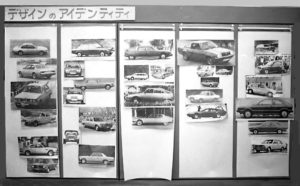
Panel studied about design identity of European cars
Commission to Aldo Sessano
President Kubo, who has been involved in design development with a strong commitment since becoming president in 1973, had shown leadership in design with the Galant Sigma/Lambda and Mirage, but for the development of the Lancer EX, he decided to ask Italian designer Mr. Aldo Sessano to make design proposals. Although the company had previously asked Mr. Giorgetto Giugiaro for proposals on multiple occasions, it was unclear why they switched to Mr. Sessano then.
Born in Turin, Italy in 1931, Mr. Sessano graduated from the Department of Architecture at Politecnico di Torino and joined Fiat, becoming chief designer at the age of 25. After becoming chief designer at the age of 25, he became independent at the age of 37, establishing his design firm, Sessano Associates. He worked on various industrial designs as well as automobiles. His designs were characterized by a simple and clean basic design with original features, and the Seat 1200 Sport was a typical example of his work. In 1977, after the work on the Seat 1200 Sport was completed, he hired several young designers and renamed his office Open Design. Sessano was 46 years old at the time. That same year, Mitsubishi asked him to work on the Lancer EX.

Seat 1200 Sport with clean surface treatment. Highly advanced front-end design
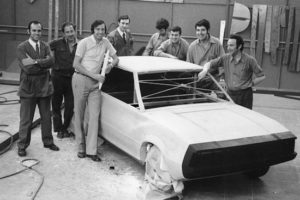
Now, we received 11 sketches from Mr. Sessano. The proposals varied widely, including notchback, fastback, semi-fastback, etc. Among them, President Kubo chose one with a clear-cut notchback and a slant nose and ordered him to fabricate a 1/1 model based on the proposal.
Development of in-house proposals
We, on the other hand, made four 1/5 models based on sketches of our team. I thought that Mitsubishi’s design identity should be “sturdiness and strength,” and set the design theme as “a neat orthodox sedan,” with a boxy design combining flat surfaces and sharp lines.
We showed President Kubo the models, and he selected Matsuo Katayama’s 6-light proposal and my 4-light proposal, and we each worked on a 1/1 model. My design was to make the body look as boxy as possible, so I changed the outermost plan view of the body from 50,000R which had been the standard for Mitsubishi sedans until then, to 70,000R to make a flat and sharp surface composition. Later, when the clay model was completed, my proposal was selected as the in-house proposal.

Writer (left) studying his model / Clay work of four 1/5 models
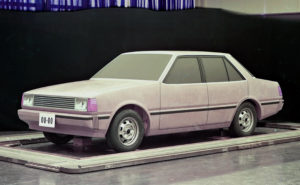
4-light proposal by writer
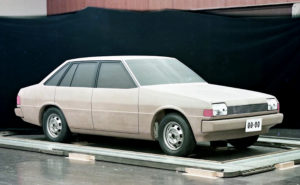
6-light proposal by Matsuo Katayama
Design selection
Toward the end of the summer of 1977, a 1/1 clay model of the in-house proposal with transparent acrylic windows was completed, while a Sessano’s model was received from Italy around the same time.
On the day of the design review, President Kubo and other executives visited the Okazaki design studio from the Tokyo headquarters, and since the weather was fine that day, the two models were displayed in the outdoor viewing court. The first impression shared by all the executives was that the two models were very similar. Indeed, the basic design of both models was orthodox and boxy, and the body side design lines and the design features around the front were similar. If they were internal proposals, the designers would intentionally go in different directions, but in this case, they happened to go in the same direction. President Kubo’s conclusion was to proceed based on the in-house proposal, referring to the good points of Sessano’s proposal, and we, Mitsubishi designers, were responsible for the subsequent design refinement for the mass production.
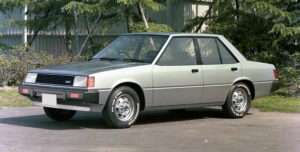
In-house proposal model
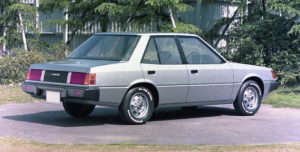
Rear window features bent glass
Toward mass production
In my view, Sessano’s proposal has a sharp sculptural form, with moderate front-to-back narrowing and surface tension, and a solid appearance that shows his high sensitivity. On the other hand, our proposal had a form that looked as if it had been made using rulers, with elaborate details, but to be honest, we regretted that it did not have the strength that we were aiming for.
In the next stage, we worked on design refinement based on the in-house proposal, incorporating technical requirements for mass production. After consulting with Chief Nakagawa, we decided to incorporate good elements of Sessano’s proposal, such as the wide “C” pillar and thick hood tip, to give the car more strength as a whole. On the other hand, we also created a new model incorporating the same technical conditions in Sessano’s proposal to compare it with the refined model. When the refined model was completed, some people said, “This is almost like Sessano’s proposal.” This was natural since we had incorporated the best parts of his proposal, but since our goal was to create a good design with the distinct individuality of Mitsubishi, we proceeded with our work without regard to such comments.
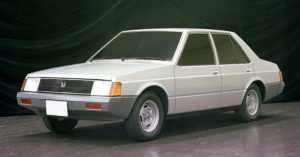
Clay model based on Sessano’s proposal incorporating further technical requirements
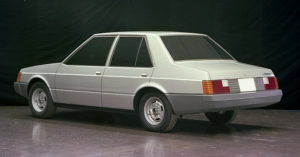
Featuring wide C-pillars and bumpers that go around to wheel cuts
Eventually, after that, I think the company came to the recognition that Sessano’s proposal was the base for Lancer EX. While this did not make much difference to us in terms of our work, it did make a big difference to Mr. Sessano, as he would seemingly receive an additional contingency fee in the contract.
One day, Mr. Sessano visited our studio for a design consultation, and upon seeing the model under work, he pointed out “This part is a little different from my original.” I responded, “It’s no problem,” and asked him to leave the finishing touches as a Mitsubishi car to us. He is a frank and friendly person, so I could easily express my opinions to him, but I think I finished it pretty much respecting his design.
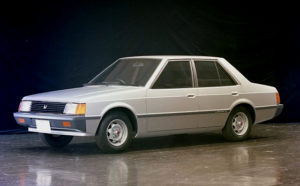
Final design incorporating good features of Sessano’s proposal
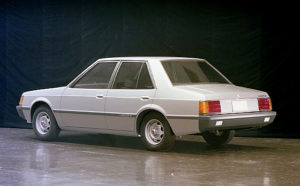
Reforming Modeler System
To digress a bit, at Mitsubishi, modelers have traditionally made clay models based on detailed drawings by designers, which tended to result in stiff designs that looked like they were created from the lines of rulers, which is exactly what happened to my model at that time. On the other hand, American modelers take sketches and rough drawings and creatively build models that reflect the designer’s intentions. We knew this, but we did not have a system in place to do so. Mitsubishi modelers at the time were positioned as technicians (direct, simple work ) and were not expected to do specialized, creative work.
Later, when I became a manager, I negotiated with the human resources department at the head office to implement a system that would allow modelers to work as specialists like designers, if they wished to do so. In this way, the practice of “free modeling,” in which modelers with a creative sense handcraft the images sought by designers, took root in our design studio.
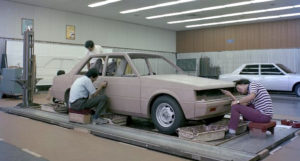
Modelers make clay models based on designer’s drawings in Mitsubishi back then
After launching
The Lancer EX went on sale in April 1979. Since it had already been six years since the 1st-gen. was launched, the car underwent a major evolution, with significant improvements to its comfortability and, for the first time as a Mitsubishi, a plastic bumper that was integrated with the body of the car. However, the world was switching to FWD vehicles with more interior space for this class. Unfortunately, the Lancer EX was not a commercial success, partly because it inherited the RWD system. However, thanks to Mr. Sessano’s cooperation, this car, together with the Galant Sigma, formed the basis of Mitsubishi’s design identity.
A few years after its launch, Mitsubishi decided to enter the WRC again with the Lancer EX for the 1981 season, which had been discontinued for a while after the 1st-gen. Lancer and we were asked to design the rally car. The car was to be equipped with a newly developed 4G63 engine that produced 250 hp from 2 liters, and we had high expectations for the car, as well as a challenging task. It was designed by a young designer Tatsuhiko Kuwahara. The car had a large front bumper with an air dam, over fenders, side air dams, a rear spoiler, and an orange coloring that was a further evolution of the 1st-gen. rally car coloring, giving it a more powerful appearance. This car was unveiled at the Tokyo Motor Show in November 1979, and it was a joy to see the remarkable transformation of the Lancer EX, which until then had looked rather modest.
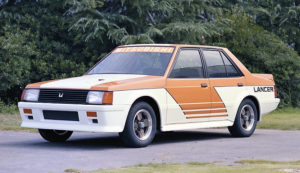
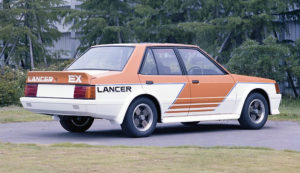
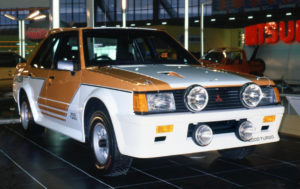
Rally car presented at the 1979 Tokyo Motor Show Photo courtesy of Motor Fan/ CARSTYLING
When the exports to Europe began, the company decided to donate a Lancer EX to Mr. Sessano in recognition of his contribution, and the project manager, Hideo Oishi, and others drove the car from the landing port in Rotterdam, the Netherlands, to his office in Turin, Italy, and handed it over in person, Mr. Sessano was very pleased. The relationship between Mitsubishi and Mr. Sessano continued for a long time, including not only passenger cars but also Mitsubishi Fuso trucks and buses, and Mitsubishi received good support from Italy.
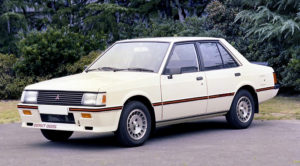
2000 Turbo for European market
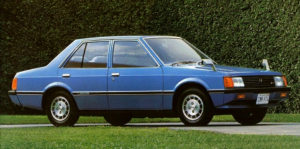
1600 XL for Japanese domestic market
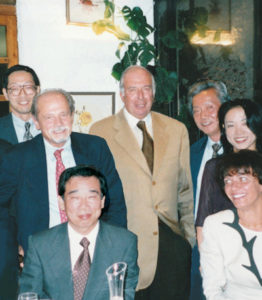
Ald Sessano (center) in Trino in 1998
September 2023
Editors sammary of Masaru Furukawa’s talk